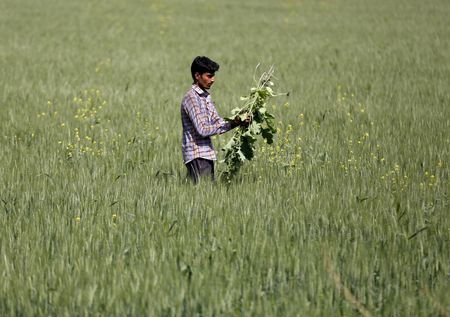By Rajendra Jadhav
MUMBAI (Reuters) – India’s year-long suspension of futures trading in key farm commodities is crimping the use of risk management tools such as hedging across its food supply chain, spurring inventory cuts as forward purchases get scaled back.
Monday’s halt, targeting items such as soybeans, edible oils, wheat, rice, and chickpeas as authorities move to cool rising inflation, was one of India’s most dramatic steps since it launched commodity futures in 2003.
But the ban on access to futures contracts may fuel volatility in domestic markets by denying traders the tools crucial to planning decisions, forcing them to cut stocks, delay long-term purchases and sales, and even limit imports.
“In the absence of futures, markets will remain clueless about shortfalls and excesses,” said Govindbhai Patel, a managing partner at edible oil trader GGN Research. “This could create even more volatility in prices.”
The finance ministry did not immediately respond to Reuters’ request for a comment.
(Graphic: India food price inflation vs key agriculture commodity prices: https://fingfx.thomsonreuters.com/gfx/ce/gdpzymlwavw/IndiaCPIVsAgriPrices.png)
Patel’s firm, which used to buy edible oils for prompt and far-month deliveries, and hedge on domestic exchanges, will now only secure its needs for up to 10 days at a time, he said.
“We used to hedge 70% to 80% of our volumes. As the hedging option is not available, we are scaling back operations,” said Patel, a trader for nearly five decades.
India is the world’s biggest importer of vegetable oil to fill more than 70% of its needs, with monthly overseas purchases of about 1.3 million tonnes.
Futures contracts were critical in ensuring the smooth flow of imports, allowing buyers and traders to hedge part of their shipments after signing deals, said Sudhakar Desai, president of the Indian Vegetable Oil Producers’ Association.
(Graphic: India’s market regulator suspended trading in key agricultural futures to tame rising inflation: https://fingfx.thomsonreuters.com/gfx/ce/lgvdwozlwpo/IndiaAgriFutures.png)
“Everyone in the supply chain has to change the way they conduct operations in the absence of hedging tools and an indicative price,” he added.
Price discovery could get more localised in the absence of national futures prices, with levels potentially weaker in producing areas and higher in regions of strong consumption, Desai said.
Outfits such as alternative investment funds and international traders could turn to overseas markets to hedge their risks, said Manoj Dalmia, head of brokerage Proficient.
But that alternative is out of reach for smaller players who require authorities’ approvals to manage commodity and currency price risk, said a Mumbai-based broker of edible oils.
TROUBLE FOR FARMERS
Regional processors who buy crops from farmers will also feel the pinch, as they are deprived of advance sales through futures contracts.
Manoj Agrawal, the managing director of Maharashtra Oil Extractions, said his firm could no longer hedge soyoil on commodity exchanges after buying soybean from farmers.
“If we can’t hedge the finished goods, we can’t take the risk of holding large amounts of raw material,” he added. “We would operate at limited capacity.”
In turn, lower inventories at stockists and processors could hurt farmers, said Nitin Kalantri, a processor of pulses based in the city of Latur in the western state of Maharashtra.
Farmers tend to flood the market with produce after harvests, but usually find willing buyers among processors and warehouse users keen to build up inventory sufficient for a year, Kalantri said.
“If everyone scales back operations because of uncertainty, then farmers would struggle in finding buyers and prices could fall.”
Soybean farmers also worry about not being able to use benchmark futures prices to time crop sales.
Ready access to nationwide futures prices had forced traders to offer comparable prices to growers nationwide. But without futures there is no way to cross-check prices, said farmer Sudhakar Kale, who harvested 2 tonnes of soybeans in September but is holding back sales in hopes of higher prices.
Other farmers, such as Ashish Naphade, said futures prices had also helped decide which crops to sow.
“Futures gave us an indication of possible prices at the time we harvest,” Naphade added.
Banks and financial institutions that lend against warehouse receipts said futures helped them value stocks so as to determine loan sizes.
“We have to be extra cautious now while lending,” said an official with one such state-run bank.
(Reporting by Rajendra Jadhav; Additional reporting by Subrata Nagchoudhury in KOLKATA and Sumit Khanna in AHMEDABAD; Editing by Gavin Maguire and Clarence Fernandez)











